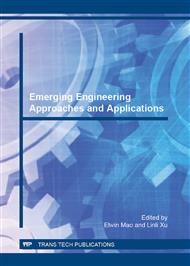[1]
C. F. Chen, C. H. Hsiao, A walsh series direct method for solving variational problems, Journal of the Franklin Institute 300 (4) (1975) 265 –280.
DOI: 10.1016/0016-0032(75)90199-4
Google Scholar
[2]
M. Razzaghi, S. Yousefi, Legendre wavelets direct method for variational problems, Mathematics and Computers in Simulation 53 (3) (2000) 185– 192.
DOI: 10.1016/s0378-4754(00)00170-1
Google Scholar
[3]
I. -R. Horng, J. -H. Chou, Shifted chebyshev direct method for solving variational problems, International Journal of Systems Science 16 (7) (1985) 855–861.
DOI: 10.1080/00207728508926718
Google Scholar
[4]
M. Razzaghi, M. Razzaghi, A. Arabshahi, Solutions of convolution integral and fredholm integral equations via double flourier series, Applied Mathematics and Computation 40 (3) (1990) 215 – 224.
DOI: 10.1016/s0096-3003(08)80003-3
Google Scholar
[5]
H. Jaddu, Direct solution of nonlinear optimal control problems using quasilinearization and chebyshev polynomials, Journal of the Franklin Institute 339 (4-5) (2002) 479 – 498.
DOI: 10.1016/s0016-0032(02)00028-5
Google Scholar
[6]
M. Razzaghi, G. N. Elnagar, Linear quadratic optimal control problems via shifted legendre state parameterization, International Journal of Systems Science 25 (1994) 393–399.
DOI: 10.1080/00207729408928967
Google Scholar
[7]
M. Razzaghi, Y. Ordokhani, Solution of nonlinear volterra-hammerstein integral equations via rationalized haar functions, Mathematical Problems in Engineering 7 (2) (2001) 205–219.
DOI: 10.1155/s1024123x01001612
Google Scholar
[8]
M. Ohkita, Y. Kobayashi, An application of rationalized haar functions to solution of linear deferential equations 33 (9) (1986) 853–862.
DOI: 10.1109/tcs.1986.1086019
Google Scholar
[9]
M. Razzaghi, Y. Ordokhani, Solution of deferential equations via rationalized haar functions, Mathematics and Computers in Simulation 56 (3) (2001) 235–246.
DOI: 10.1016/s0378-4754(01)00278-6
Google Scholar
[10]
V. Yen, M. Nagurka, Optimal control of linearly constrained linear systems via state parameterization, Optimal Control Appl. Mehods 25(1992) 393–399.
DOI: 10.1002/oca.4660130206
Google Scholar
[11]
D. Kleinman, T. Fortmann, M. Athans, B. Bolt, Newman, On the design of linear systems with piecewise-constant feedback gains, IEEE Trans. Automat. Contr. 13 (1968) 354–361.
DOI: 10.1109/tac.1968.1098926
Google Scholar
[12]
J. Vlassenbroeck, A chebyshev polynomial method for optimal control with state constraints, Automatica 24 (4) (1988) 499 – 506.
DOI: 10.1016/0005-1098(88)90094-5
Google Scholar
[13]
V. Yen, M. Nagurka, Linear quadratic optimal control via fourier-based state parameterization, Journal of Dynamic Systems, Measurement, and Control 113 (2) (1991) 206–215.
DOI: 10.1115/1.2896367
Google Scholar


